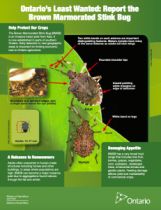Brown Marmorated Stink Bug (Halyomorpha halys)
French common name: Punaise diabolique
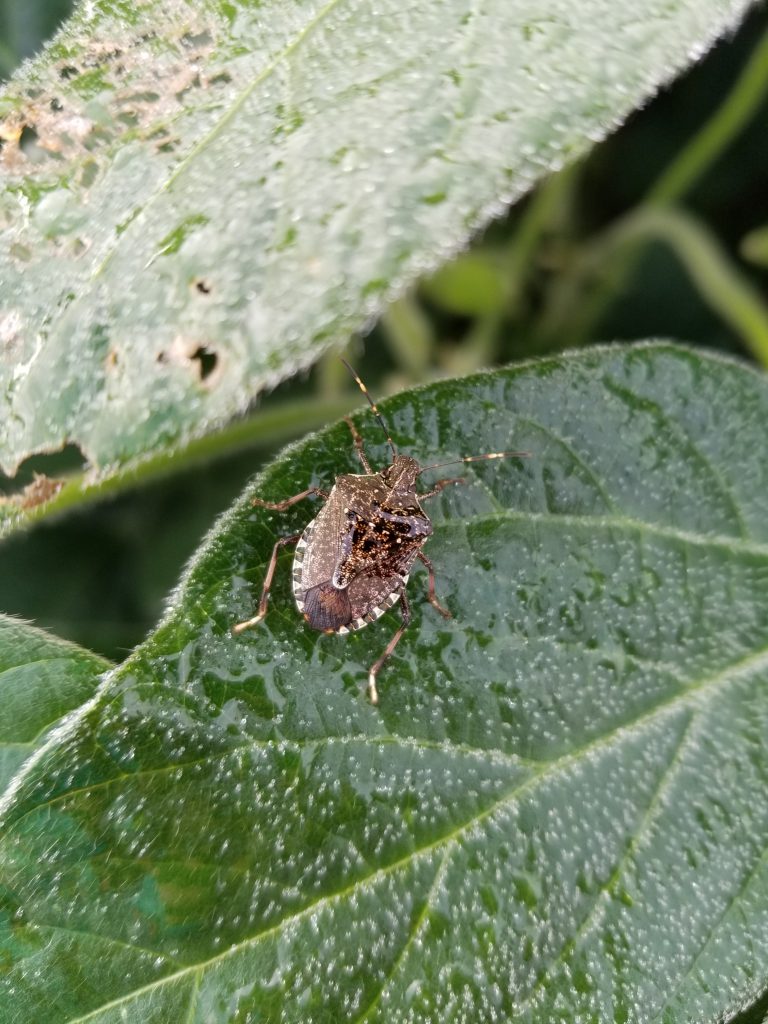
Photo by Alison Grant
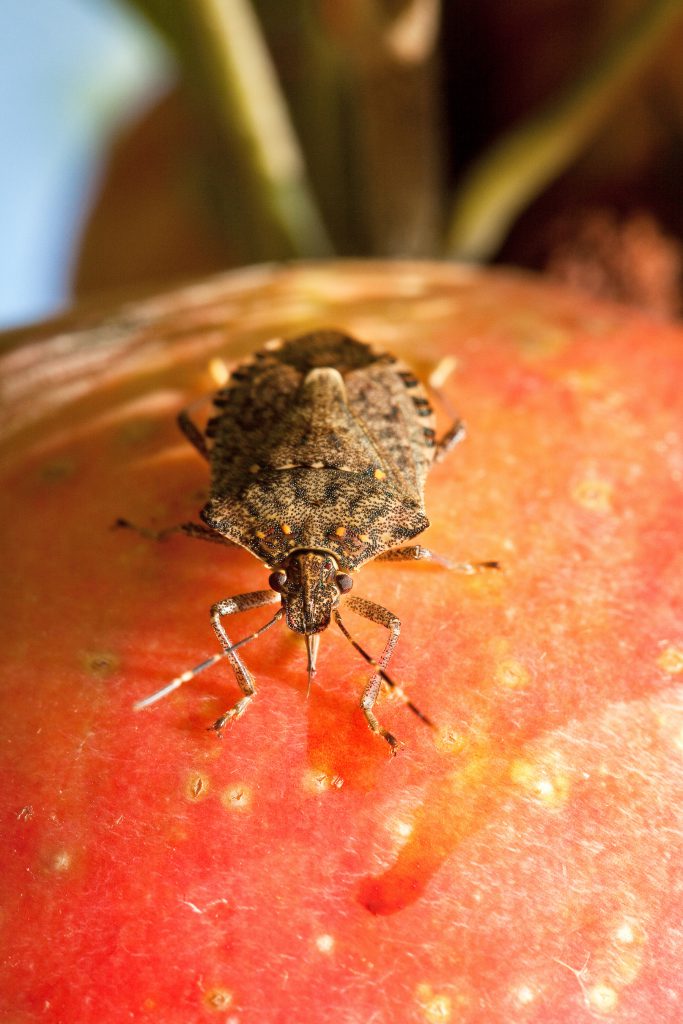
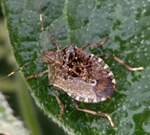
Order: Hemiptera
Family: Pentatomidae
The brown marmorated stink bug (BMSB; Halyomorpha halys) is native to Taiwan, Japan, Korea and China. The first identification of the BMSB in North America was in Pennsylvania in 2001, but records of this insect go back to the mid-1990’s. BMSB was first detected in Canada in Hamilton, Ontario in 2010 (Fogain and Graff, 2011). To date, the BMSB has been detected/ intercepted in 46 states in the U.S. and in five provinces in Canada (Ontario, Quebec, British Columbia, Alberta, and PEI). BMSB has become established in local pockets in Ontario, British Columbia, and Quebec, causing nuisance and minor agricultural problems.
In US states where it is established in large populations, BMSB is considered a nuisance and agricultural pest that can be found in and outdoors. In particular, BMSBs have become a serious agricultural pest in Virginia, West Virginia, New Jersey, Pennsylvania, Tennessee, Maryland, Oregon, Michigan, North Carolina, New York and Delaware. In addition to North America, BMSB has been detected in several European countries including Hungary, Germany, Switzerland, Russia and Italy.
BMSB is a serious agricultural pest because its adults and nymphs feed on over 35 fruiting crops, causing damage to the fruit flesh and skin, making them unsuitable for food markets, but feeding from BMSB is not limited to agricultural crops. BMSB has over 170 confirmed non-crop hosts in North America and is a landscape-level pest that moves between non-crop and crop hosts during the growing season. Research on this pest is ongoing to determine the extent of its potential impacts as well the efficacy of monitoring, management and control options that are available.
Quick Tips
There are many species present in Canada that look similar to BMSB. Look-alikes include: the spined soldier bug, rough stink bug, and dusky stink bug. The most distinguishing characteristic for the adult BMSB is that it has two white bands on its antennae. BMSB do not bite as their mouth piece is specifically designed to feed on plants.



- BMSB can invade your house! Seal cracks that lead indoors as this is one of the main ways in which the BMSB can get inside residential and business buildings.
- BMSB can be removed from indoor locations with the help of a vacuum, hand picked with a tissue, or crushed and then disposed of in soapy water.
- A wide variety of commercial and homemade traps can be used where BMSB is abundant.
- Look for ‘cat-faced’ damaged fruit as a sign of BMSB damage to fruiting trees.
- Report any sightings!
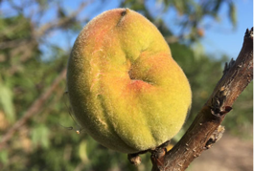
Physical Description
Eggs: 1.6 x 1.3 mm, barrel-shaped; pale green initially then turn white with a white halo-like circle on the upper part of the egg. Closer to hatching, red eye spots develop an egg breaker (black triangle on top of halo). Eggs are usually found in clusters of approximately 25 on the underside of leaves.
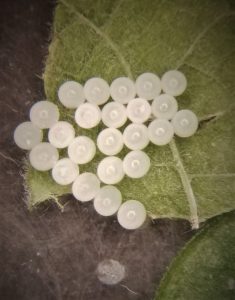
Photo by Alison Grant
Nymphs: Look similar to ticks. The nymphs shed their exoskeleton in five nymphal stages, ranging from 2.4 mm to 12 mm in length, until they reach their winged adult form.
First instars: Yellowish-orange abdomen, black thorax.
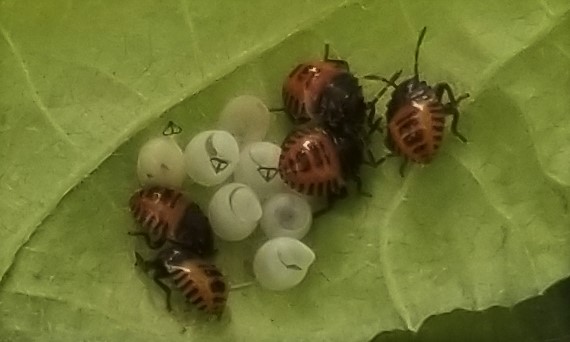
Photo by Alison Grant
Second instars: Mostly black with orange abdomens.
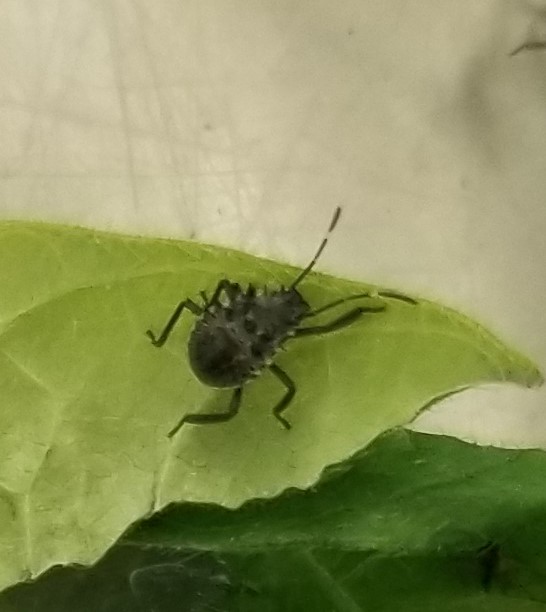
Photo by Alison Grant
Third through fifth instars: Banding on the antennae of the nymphs and a single white band on each of the legs.
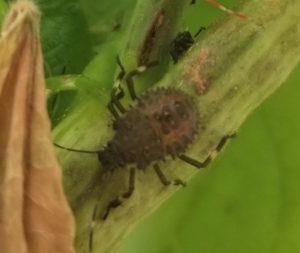
Photo by Alison Grant
Adults: 14-17 mm in length, brown and white mottled appearance with smooth rounded “shoulders”. The most distinguishable characteristic is the two white bands on each antenna.
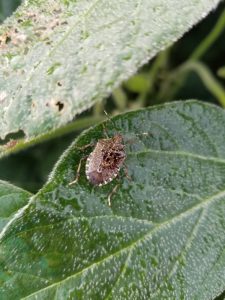
Photo by Alison Grant
Life Cycle
Adult female BMSB lay eggs over a period ranging from two weeks to several months. Each of the nymphal stages lasts for about a week, but this duration varies based on the temperature of the area at the time. Newly mature adults in the fall feed before heading to protected overwintering sites. In the springtime, adults emerge over a prolonged period ranging from mid-April to early June. Females require two weeks of feeding, post-emergence, before they become sexually active and can mate. Female BMSB can lay more than 400 eggs per year, making the risk of crop damage high. BMSB is considered damaging to the fruit in both its nymphal and adult stages because it injects tissue-destroying enzymes into fruit and sucks the fruit’s juice in both stages.
The BMSB attacks a wide range of crops and non-crop plants ranging from grapes to orchard crops, bush and tree ornamentals, to vegetable and field crops, such as apples, peaches, pears, mulberries, soybeans and sweet corn. This is concerning to Ontario’s economy as large BMSB populations are found in the fruit-growing regions of Ontario (e.g. Niagara) that grow peaches, grapes and other fruits extensively. Non-crop hosts in Ontario include buckthorn, catalpa, honeysuckle, tree of heaven, black walnut and Manitoba maple trees.
- Destroyed tissue (appears corky)
- Distorted skin
- Hardened flesh

Photo: Cory Penca, Univeristy of Florida
BMSB has been detected/ intercepted in most U.S. states, as well as in Ontario, Quebec and British Columbia. BMSB was intercepted on a shipment into Prince Edward Island and was destroyed.
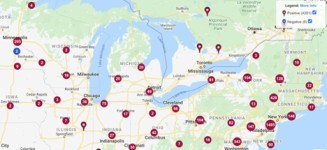
EDDMapS. 2020. Early Detection & Distribution Mapping System. The University of Georgia – Center for Invasive Species and Ecosystem Health. Available online at http://www.eddmaps.org/; last accessed July 24, 2020.
In the United States, BMSB is a serious agricultural problem. In Ontario, BMSB has been a nuisance pest for homeowners for the most part, yet growers are continuing to see more BMSB injuries on their crops in areas where it has been detected and determined to be established.
Economic impacts
Amongst the wide variety of crop and non-crop hosts that BMSB feeds on, this insect prefers the reproductive parts of the crop and agricultural output. This puts fruit, vegetable, and agronomic crop growers where BMSB is established at a threat of an economic loss. The economic injury for apple growers had been estimated to be around $37 million US dollars , as of 2010, in the mid-Atlantic states with some farmers losing more then 90% of their peach crop yield (Leskey et al., 2012). BMSB threatens Ontario’s $145 million tender fruit and grape industry including peaches, pears, plums, and nectarines (OMAFRA, 2019), and the $138 million apple industry (OMAFRA, 2019). BMSB infestations have already been found affecting wine grapes in the U.S. in Virginia, Oregon, and New Jersey. Ontario’s prominent wine and grape industry might be jeopardized with the spread and persistence of the BMSB, with a total economic impact of $3.3 billion (Frank, Rimerman & Co. LLP, 2013) including impacts on jobs, taxes, and tourism. The potential impacts mentioned in this section are meant to provide a glimpse into a wide range of potential economic threats that BMSB may impose in areas where it is established.

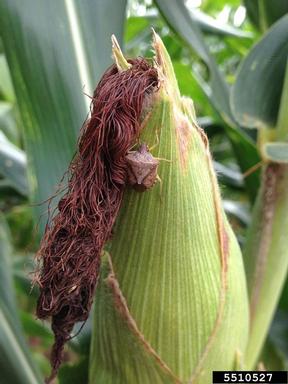
Photo: Brian Little, The University of Georgia, Bugwood.org.
Ecological impacts
BMSB mainly targets fruiting structures, seeds, and pods. BMSB also feeds on the vegetative parts of plants, flower buds, leaves, and stems. It has been recorded that the BMSB can feed through the bark of thin-barked trees, often affecting young trees; however, the impact of BMSB feeding on young trees is still being evaluated.
In addition, management options for BMSB include insecticides, which may have associated environmental impacts and have a large non-target insect impact.
Social impacts
BMSB poses a challenge to many farmers across North America, impacting their livelihood and well-being. BMSB is not only an agricultural pest, but also a nuisance pest for homeowners causing problems in urban areas. BMSB makes its way into homes and buildings, especially during the fall season, releasing odors and producing secretions that can stain surfaces.
Detect
Pheromones, black lights, and pyramid traps are used as tools for detecting BMSB if they are present near where the traps are set. Agencies may consider using pheromone traps as a early detection tool. A pheromone lure is placed inside a pyramid trap to attract BMSB, guiding it in one direction to the holding chamber. See photo below for more detail. Alongside agencies, community members can preform visual surveys on preferred host plants, sweep nets, and tapping trays as another tool for detecting BMSB.
Respond and Control
Mechanical
Physical barriers such as placing bags on fruit growing in gardens and in small scale orchards can prevent BMSB damage.
Tree banding can be used to stop nymphs from moving up a tree trunk (please note that this method may be impractical in cases where canopies are intertwined).
Outdoors
Suggested methods to try:
- Tree banding in an attempt to impede the movement of the BMSB nymph populations.
- Aggregation pheromone traps in the peripheries of field crops may assist in the reduction of pesticides sprayed in the field.
- Natural ingredients such as lemongrass and cloves may be used as BMSB repellents. Creating slow release formulas for the essentials oils or combining this technique with other methods may increase its effectiveness against BMSB
Indoors
Prevention is key to dealing with BMSB indoors:
- It is important to repair cracks and seal any spaces around windows to prevent BMSB from finding their way inside.
- If BMSB populations are found near or in living spaces, an old vacuum cleaner may be used to capture BMSB, as the captured BMSB can leave behind an unpleasant smell and stains within the vacuum. Drop the captured insects into soapy water to kill them.
Biological
Studies are being undertaken to determine whether the egg parasitoid wasp, Trissolcus japonicus, is specific to BMSB. Trissolcus japonicus controls 50-80% of BMSB populations in its native range in Asia by parasitizing the BMSB eggs (Yang et al., 2009). Research on whether T. japonicus is a suitable biological control of BMSB in Canada and the U.S. is still ongoing and will most likely be the best option for long term management.
Field surveys conducted in North America have showed that while several native enemies pray on BMSB, in its invaded range, they do not provide enough control to offset the agricultural impact from BMSB (Rice et al., 2014).
Chemical
In Canada, there limited commercially registered products that are currently available for control or suppression of the BMSB (Fraser, 2013). Please refer to the Pest Management Regulatory Agency label database as products are subject to change.
Although chemical control options exist, there are associated challenges with this type of approach. In some cases, BMSB has been noted to develop resistance against insecticides. In addition, the residual activity of the insecticides is limited, so unless the insect comes into contact with the insecticide directly via spray contact or shortly thereafter, it is not proven to be an effective management tool.
Fact Sheets
Research
Bergmann, E., K. M. Bernhard, G. Bernon, M. Bickerton, S. Gill, C. Gonzales, G. C. Hamilton, C. Hedstrom, K. Kamminga, C. Koplinka-Loehr, G. Krawczyk, T. P. Kuhar, B. Kunkel, J. Lee, T. C. Leskey, H. Martinson, A. L. Nielsen, M. Raupp, P. Shearer, P. Shrewsbury, J. Walgenbach, J. Whalen, and N. Wiman. 2016. Host plants of the brown marmorated stink bug in the U.S. Stop BMSB, Northeastern IPM Center- USDA.
Fogain, R., and S. Graff. 2011. First Records of the invasive pest, Halyomorpha Halys (Hemiptera: Pentatomidae), in Ontario and Quebec. J. Entomol. Soc. Ontario. 142: 45–48.
Hamilton, G. C. 2009. Brown marmorated stink bug. Am. Entomol. 55: 19–20.
Haye, T., T. Gariepy, K. Hoelmer, J. P. Rossi, J. C. Streito, X. Tassus, and N. Desneux. 2015. Range expansion of the invasive brown marmorated stinkbug, Halyomorpha halys: an increasing threat to field, fruit and vegetable crops worldwide. J. Pest Sci. 88: 665–673.
Leskey, T. C., G. C. Hamilton, A. L. Nielsen, D. F. Polk, C. Rodriguez-Saona, J. Christopher Bergh, D. Ames Herbert, T. P. Kuhar, D. Pfeiffer, G. P. Dively, C. R. R. Hooks, M. J. Raupp, P. M. Shrewsbury, G. Krawczyk, P. W. Shearer, J. Whalen, C. Koplinka-Loehr, E. Myers, D. Inkley, K. A. Hoelmer, D. H. Lee, and S. E. Wright. 2012a. Pest status of the brown marmorated stink bug, Halyomorpha halys in the USA. Outlooks Pest Manag. 23: 218–226.
Leskey, T. C., and A. L. Nielsen. 2018. Impact of the invasive brown marmorated stink bug in North America and Europe: History, biology, ecology, and management. Annu. Rev. Entomol. 63: 599–618.
Morrison, W. R., B. R. Blaauw, B. D. Short, A. L. Nielsen, J. C. Bergh, G. Krawczyk, Y. L. Park, B. Butler, A. Khrimian, and T. C. Leskey. 2019. Successful management of Halyomorpha halys (Hemiptera: Pentatomidae) in commercial apple orchards with an attract-and-kill strategy. Pest Manag. Sci. 75: 104–114.
Rice, K. B., C. J. Bergh, E. J. Bergmann, D. J. Biddinger, C. Dieckhoff, G. Dively, T. Gariepy, G. Hamilton, T. Haye, A. Herbert, K. Hoelmer, C. R. Hooks, A. Jones, G. Krawczyk, T. Kuhar, H. Martinson, W. Mitchell, A. L. Nielsen, D. G. Pfeiffer, M. J. Raupp, C. Rodriguez-saona, P. Shearer, P. Shrewsbury, P. D. Venugopal, J. Whalen, N. G. Wiman, T. C. Leskey, and J. F. Tooker. 2014. Biology, ecology, and management of brown marmorated stink bug (Hemiptera: Pentatomidae). J. Integr. Pest Manag. 5: 1–13.
Walker, A. 2015. 1 brown marmorated stink bug discovered on P.E.I. CBC News. (https://www.cbc.ca/news/canada/prince-edward-island/1-brown-marmorated-stink-bug-discovered-on-p-e-i-1.3072483)
Yang, Z.-Q., Y.-X. Yao, L.-F. Qiu, and Z.-X. Li. 2009. A new species of Trissolcus (Hymenoptera: Scelionidae) parasitizing eggs of Halyomorpha halys (Heteroptera: Pentatomidae) in China with comments on its biology. Ann. Entomol. Soc. Am. 102: 39–47.
Further Reading
Thank you Caitlin MacDonald (University of Guelph) for review and edit of this page.

